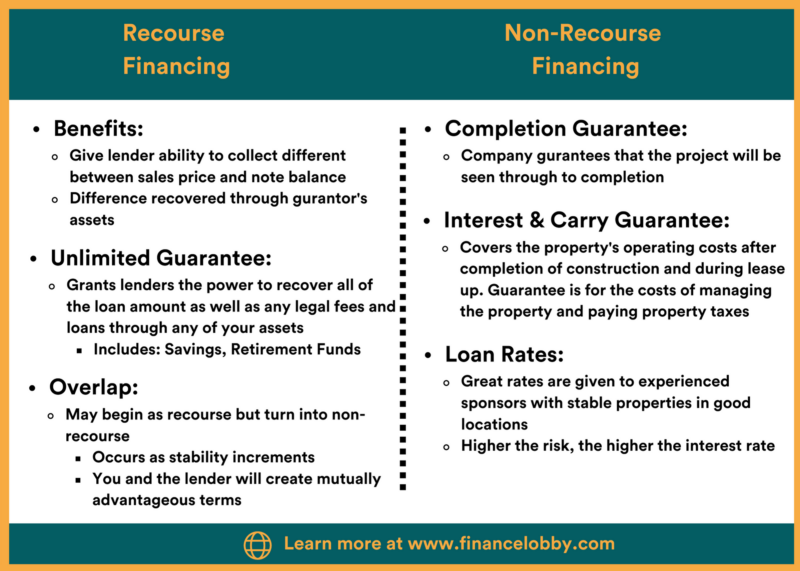How to Choose Between Recourse and Non-Recourse Financing for CRE

If you are planning to invest in commercial real estate, you may have heard the terms “recourse” and “non-recourse financing.” These are the two basic categories that most property debts are put into. As you navigate the complex world of CRE lending, understanding how to finance a commercial property will be easier than you think. All you need is a solid understanding of the differences between recourse and non-recourse financing, including why all CRE investors choose the latter when they finance a commercial property.
What Is Non-Recourse Financing in Commercial Real Estate?
First, it is helpful to remember that “non-recourse” is really just industry jargon for “guarantee.” So, when you must decide between a recourse and non-recourse loan to finance your commercial property, you are really choosing between a loan that is guaranteed and one that is not.
When seeking to finance a CRE property, investors choose non-recourse loans so that if they unfortunately default, they cannot be held liable by the lender. The only source of repayment is the collateral that was used to secure the loan: for example, the real estate itself. While the lender can seize and sell the property in the event of a default, the borrower’s non-pledged assets or properties cannot be taken. You can see, then, why non-recourse loans are preferred for CRE financing.
Why Do Lenders Prefer Recourse Loans?
While issuing any CRE loan will always involve some element of risk, lenders understandably like to limit it as much as possible. A recourse loan, then, can help commercial real estate lenders be repaid if the CRE property does not do as well as expected.
A commercial property that is financed through a recourse loan will give the lender the ability to collect the difference between the property’s sale price and the note’s balance. The lender can recover the difference through the guarantor’s assets, including securities and other real estate properties.
What Is an Unlimited Guarantee?
When you are looking into how to finance your commercial property, pay special attention to unlimited guarantees. These give lenders the power to recover all of the loan amount as well as any legal fees and loans through any of your assets, including your savings and retirement fund.
How Do Recourse and Non-Recourse Loans Overlap and Why?
When you seek to finance your commercial property, remember that the line between recourse and non-recourse loans is not always cut and dried. You and the lender will have a lot of leeway to create terms that are advantageous for you both, so sometimes your CRE financing will begin as a recourse loan and then eventually turn into a non-recourse loan. This happens when your property starts to generate enough cash flow to be stable.
How Are Non-Recourse Loans Structured in Commercial Real Estate?
When you are learning about how to finance your CRE property, remember that whether you get a recourse or non-recourse loan, they will look essentially the same. They will both have interest rates, term lengths, and other similar details. Whether your CRE loan is recourse or non-recourse will be just one of many terms to agree upon.

How Can a CRE Investor Get a Non-Recourse Loan?
As you would expect, whether you are able to finance your commercial real estate property with a non-recourse loan will depend on how much of a risk the lender sees you or your project as being.
The lender will, in part, look at five things when making their risk assessment: the person or company that owns and is managing the project, the loan-to-value (ltv) ratio, any cash the property is already generating, the location of the CRE property, and any construction that will be needed to build/renovate the property.
In looking at these factors, the lender will determine the risk associated with financing the CRE property. The lower it is, the more likely it will be that the borrower will be offered non-recourse terms.
What Is a Bad Boy Carve Out?
You may have heard of Bad Boy Carve Outs, which are essentially loan documents that protect the lender if a borrower runs their property in a dishonest way. Bad Boy Carve Outs are common in non-recourse loans. Typical actions include misrepresentation, fraud, and negligence, though there are others.
Bad Boy Carve Outs can be very useful for the lender. For example, consider a CRE property that has been doing well. If the economy suddenly changes, as it did during the pandemic, the borrower might not be able to make their loan payments. The usual non-recourse loan terms would not protect the issuer from the borrower quietly taking cash from the property before it eventually defaults. Bad Boy Carve Outs are meant to protect lenders from situations like this.
As the borrower, you can expect to see Bad Boy Carve Outs that will make you liable for the CRE lender’s loss if you commit waste at your commercial real estate property.
What Else Can You Expect During the Negotiations for a Non-Recourse Loan?
When financing your commercial real estate property, you will negotiate your customized terms with the lender. Even if you do receive a non-recourse loan, you can still expect to see other guarantees:
- Completion Guarantee
- This is what it sounds like: the person or company guarantees that the project will be seen through to completion.
- Interest & Carry Guarantee
- This covers the property’s operating costs after completion of construction and during lease up. The guarantee is for the costs of managing the property and paying property taxes and insurance. It covers interest, default interest, and late charges on the loan.
When you are financing your commercial property with a non-recourse loan, you can expect to negotiate fewer guarantees for a permanent loan for a stable property, one that has little-to-no construction and that is already generating a cash flow. With low-risk properties, you will usually only have carve-out guarantees.
What About Loan Rates for CRE Non-Recourse Financing?
Like all types of commercial real estate loans, the non-recourse loan rates you get will depend on the debt’s source and deal’s terms. Two principal sources of non-recourse loans are life insurance companies and debt funds.
While you are likely familiar with life insurance companies, debt funds may be new to you, so here is a quick primer:
You can think of debt funds as private equity-backed capital that lends money to people who want to finance their commercial real estate properties. They are, in effect, real estate investment companies. While debt funds issue non-recourse loans, you can expect them to have higher interest rates and to require higher leverage. The terms offered by debt funds ultimately mean that they are able to take over the property in the event of a default.
When exploring funding for your CRE property, the loan rates you get from life insurance companies and debt funds will vary depending on the location of the property and the experience of the sponsor.
Great interest rates on non-recourse loans are normally given to experienced sponsors whose properties are in good locations and are stable. Higher interest rates for non-recourse loans are given to those sponsors who must build their properties in locations that are not as desirable. The higher the risk, the higher the interest rate.
What Are Some Other Reasons for Using Non-Recourse Loans to Finance Your Commercial Property?
With so many terms that benefit the borrower, it’s easy to understand why CRE investors choose non-recourse financing. However, there are other situations in which non-recourse financing can be the way to go, especially in terms of a partnership.
Consider the possibility of an investor working with a movie producer to build a new film studio in Austin, Texas. The investor has put 70% equity into the project while their partner has put in 30%. Eventually, life happens: the partner experiences a financial downturn and is no longer able to fulfill their side of the deal. What now?
No matter which way the investor turns, they are faced with the reality that they may be stuck with covering their partner’s 30%. If they don’t, the CRE lender may go after their assets to pay for the defaulted commercial property loan – unless the investor and partner decided in the beginning to get non-recourse financing for their commercial project.
Commercial real estate investors also like to receive non-recourse financing for speculative projects. Let’s say that an investor wants to purchase a vacant grocery store and turn it into a thrift store. Can they complete the renovations, attract customers, and consistently turn a profit? Perhaps yes, perhaps no. If the property is worth $10M and the borrower receives a loan for $7M, they will have a 70% loan-to-value ratio.
If a few years later the property is struggling to generate cash flow, the borrower may default on their CRE loan, and selling the property may not help the lender receive the balance of the loan. Non-recourse loans will protect the borrower, who can move on. The loss will be experienced by the lender as the building is foreclosed and liquidated.
What Is the Right Financing for Your Commercial Real Estate Property?
Settling on the right terms for financing your commercial property is incredibly important. As you negotiate with the lender, be sure to read the fine print. Don’t be afraid to ask questions and to ask for what you want. If for any reason you are unable to get non-recourse financing, be doubly sure to understand the terms so that you are clear on what you are agreeing to.
Once you receive your CRE financing, be sure to celebrate and then get to work making the property embody the dream you have had for years. Being the owner of a commercial property can be the adventure of a lifetime.
Finance Lobby is an online CRE lending marketplace that is making it faster and more efficient for commercial real estate brokers and lenders to find their perfect deals. To learn more about Finance Lobby, please see https://financelobby.com/.


